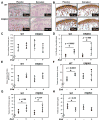Sex differences in the estrogen-dependent regulation of temporomandibular joint remodeling in altered loading
- PMID: 27903449
- PMCID: PMC5359071
- DOI: 10.1016/j.joca.2016.11.008
Sex differences in the estrogen-dependent regulation of temporomandibular joint remodeling in altered loading
Abstract
Objective: Temporomandibular joint (TMJ) diseases predominantly afflict women, suggesting a role of estrogen in the disease etiology. Previously, we determined that decreased occlusal loading (DOL) inhibited collagen type II (Col2) expression in the mandibular condylar cartilage (MCC) of female wild-type (WT) mice whereas no change was observed in males. This decrease in chondrogenesis was abolished by estrogen receptor beta (ERβ) deficiency in females. Therefore, the goal of this study was to examine the role of estradiol - ERβ signaling in mediating DOL effects in male mice to further decipher sex differences.
Methods: Male 21 day-old WT and ERβKO male mice were treated with either placebo or estradiol and exposed to normal or DOL for 4 weeks. Cartilage thickness and cell proliferation, gene expression and immunohistochemistry of chondrogenic markers and estrogen receptor alpha (ERα), and analysis of bone histomorphometry via microCT were completed to ascertain the effect of estradiol on DOL effects to the TMJ.
Results: ERβKO male mice lack a MCC phenotype. In both genotypes, estradiol treatment increased Col2 gene expression and trabecular thickness. DOL in combination with estradiol treatment caused a significant increase in Col2 gene expression in both genotypes.
Conclusions: The sex differences in DOL-induced inhibition of Col2 expression do not appear to be mediated by differences in estradiol levels between male and female mice. Greater understanding on the role of estrogen and altered loading are critical in order to decipher the sex dimorphism of TMJ disorders.
Keywords: Decreased occlusal loading; Estradiol; Estrogen receptor β; Mandibular condylar cartilage; Sex differences; Temporomandibular joint.
Copyright © 2016 Osteoarthritis Research Society International. Published by Elsevier Ltd. All rights reserved.
Conflict of interest statement
Figures







References
-
- Lipton JA, Ship JA, Larach-Robinson D. Estimated prevalence and distribution of reported orofacial pain in the United States. J Am Dent Assoc. 1993;124:115–121. - PubMed
-
- Manfredini D, Guarda-Nardini L, Winocur E, Piccotti F, Ahlberg J, Lobbezoo F. Research diagnostic criteria for temporomandibular disorders: a systematic review of axis I epidemiologic findings. Oral Surg Oral Med Oral Pathol Oral Radiol Endod. 2011;112:453–462. - PubMed
-
- Tanaka E, Detamore MS, Mercuri LG. Degenerative disorders of the temporomandibular joint: etiology, diagnosis, and treatment. J Dent Res. 2008;87:296–307. - PubMed
-
- Milam SB. Pathogenesis of degenerative temporomandibular joint arthritides. Odontology. 2005;93:7–15. - PubMed
-
- Manfredini D, Arveda N, Guarda-Nardini L, Segù M, Collesano V. Distribution of diagnoses in a population of patients with temporomandibular disorders. Oral Surg Oral Med Oral Pathol Oral Radiol. 2012;114:e35–e41. - PubMed
Publication types
MeSH terms
Substances
Grants and funding
LinkOut - more resources
Full Text Sources
Other Literature Sources

